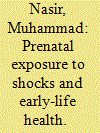|
|
|
Sort Order |
|
|
|
Items / Page
|
|
|
|
|
|
|
| Srl | Item |
| 1 |
ID:
166744


|
|
|
|
|
| Summary/Abstract |
This study explores the correlates of perceived insecurity among the households in Pakistan. For this purpose, data from the third round of Pakistan Panel Household Survey are merged with terrorist incidents taken from Global Terrorism Database. The results illustrate that objective risk, signified by violence in the district of residence, and victimization play an important role in the formation of perceived insecurity. Moreover, males and residents of rural areas feel more insecure than females and urban residents, respectively. Furthermore, spatial variation in violence indicates that terrorist attacks in the first-order contiguous districts (i.e. the immediate neighbors) are also associated with subjective insecurity. These are crucial findings because behavioral changes, such as perceived insecurity, could force the households to make suboptimal investment decisions. More importantly, since changes in behavioral parameters may be highly persistent, this study cautions that violence in Pakistan may have potentially long-term impacts on social welfare.
|
|
|
|
|
|
|
|
|
|
|
|
|
|
|
|
| 2 |
ID:
125664


|
|
|
|
|
| Publication |
2013.
|
| Summary/Abstract |
This paper explores the effects of financial development, economic growth, coal consumption and trade openness on environmental performance using time series data over the period 1965-2008 in case of South Africa. The ARDL bounds testing approach to cointegration has been used to test the long run relationship among the variables while short run dynamics have been investigated by applying error correction method (ECM). The unit root properties of the variables are examined by applying Saikkonen and Lütkepohl (2002. Econometric Theory 18, 313-348) structural break unit root test. Our findings confirmed long run relationship among the variables. Results showed that a rise in economic growth increases energy emissions, while financial development reduces it. Coal consumption has significant contribution to deteriorate environment in South African economy. Trade openness improves environmental quality by reducing the growth of energy pollutants. Our empirical results also verified the existence of environmental Kuznets curve. This paper opens up new insights for South African economy to sustain economic growth by controlling environment from degrdation through efficient use of energy.
|
|
|
|
|
|
|
|
|
|
|
|
|
|
|
|
| 3 |
ID:
103528


|
|
|
|
|
| Publication |
2011.
|
| Summary/Abstract |
This study investigates the relationship between carbon emissions, income, energy consumption, and foreign trade in Pakistan for the period 1972-2008. By employing the Johansen method of cointegration, the study finds that there is a quadratic long-run relationship between carbon emissions and income, confirming the existence of Environmental Kuznets Curve for Pakistan. Moreover, both energy consumption and foreign trade are found to have positive effects on emissions. The short-run results have, however, denied the existence of the Environmental Kuznets Curve. The short-run results are unique to the existing literature in the sense that none of the long-run determinants of emissions is significant. The contradictory results of short- and long-run give policy makers the opportunity to formulate different types of growth policies for the two terms taking environmental issues into consideration. In addition, the uni-directional causality from growth to energy consumption suggests that the policy makers should not only focus on forecasting future demand for energy with different growth scenarios but also on obtaining the least cost energy. Furthermore, the absence of causality from emissions to growth suggests that Pakistan can curb its carbon emissions without disturbing its economic growth.
|
|
|
|
|
|
|
|
|
|
|
|
|
|
|
|
| 4 |
ID:
179958


|
|
|
|
|
| Summary/Abstract |
Simultaneous exposure to natural calamities and conflict shocks is a phenomenon that has been largely understudied. The interplay between natural disasters and conflict shocks can have adverse effects extending beyond the current family members to children in utero. The current paper tries to fill this gap by investigating the impact of floods on pregnancy and birth outcomes across conflict-affected and unaffected districts in Pakistan. Using mother fixed effects strategy, the results suggest that in-utero exposure to violence during flood increases the probability of small birth size by 4.7 percentage points. Moreover, simultaneous exposure to flood and violence increases the probability of miscarriages and stillbirths by 6 and 1.9 percentage points, respectively. Significant heterogeneities are found across income groups and education levels.
|
|
|
|
|
|
|
|
|
|
|
|
|
|
|
|
|
|
|
|
|